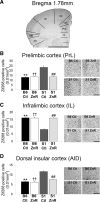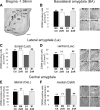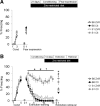Rescue of impaired fear extinction and normalization of cortico-amygdala circuit dysfunction in a genetic mouse model by dietary zinc restriction
- PMID: 20943900
- PMCID: PMC3149823
- DOI: 10.1523/JNEUROSCI.0849-10.2010
Rescue of impaired fear extinction and normalization of cortico-amygdala circuit dysfunction in a genetic mouse model by dietary zinc restriction
Abstract
Fear extinction is impaired in neuropsychiatric disorders, including posttraumatic stress disorder. Identifying drugs that facilitate fear extinction in animal models provides leads for novel pharmacological treatments for these disorders. Zinc (Zn) is expressed in neurons in a cortico-amygdala circuit mediating fear extinction, and modulates neurotransmitter systems regulating extinction. We previously found that the 129S1/SvImJ mouse strain (S1) exhibited a profound impairment in fear extinction, coupled with abnormalities in the activation of the extinction circuit. Here, we tested the role of Zn in fear extinction in S1 and C57BL/6N reference strain (B6) by feeding the mice a Zn-restricted diet (ZnR) and testing for fear extinction, as well as neuronal activation of the extinction circuit via quantification of the immediate-early genes c-Fos and Zif268. Results showed that (preconditioning or postconditioning) ZnR completely rescued deficient extinction learning and long-term extinction retrieval in S1 and expedited extinction learning in B6, without affecting fear acquisition or fear expression. The extinction-facilitating effects of ZnR were associated with the normalization of Zif268 and/or c-Fos expression in cortico-amygdala regions of S1. Specifically, ZnR increased activity in infralimbic cortex, lateral and basolateral amygdala nuclei, and lateral central amygdala nucleus, and decreased activity in prelimbic and insular cortices and medial central amygdala nucleus. ZnR also increased activation in the main intercalated nucleus and decreased activation of the medial paracapsular intercalated mass in S1. Our findings reveal a novel role for Zn in fear extinction and further support the utility of the S1 model for identifying extinction facilitating drugs.
Figures






Similar articles
-
Differential Alterations in Cortico-Amygdala Circuitry in Mice with Impaired Fear Extinction.Mol Neurobiol. 2020 Feb;57(2):710-721. doi: 10.1007/s12035-019-01741-3. Epub 2019 Aug 28. Mol Neurobiol. 2020. PMID: 31463877
-
Impaired fear extinction learning and cortico-amygdala circuit abnormalities in a common genetic mouse strain.J Neurosci. 2008 Aug 6;28(32):8074-85. doi: 10.1523/JNEUROSCI.4904-07.2008. J Neurosci. 2008. PMID: 18685032 Free PMC article.
-
Impaired extinction of learned fear in rats selectively bred for high anxiety--evidence of altered neuronal processing in prefrontal-amygdala pathways.Eur J Neurosci. 2008 Dec;28(11):2299-309. doi: 10.1111/j.1460-9568.2008.06511.x. Epub 2008 Nov 3. Eur J Neurosci. 2008. PMID: 19019199 Free PMC article.
-
Sex differences and chronic stress effects on the neural circuitry underlying fear conditioning and extinction.Physiol Behav. 2013 Oct 2;122:208-15. doi: 10.1016/j.physbeh.2013.04.002. Epub 2013 Apr 23. Physiol Behav. 2013. PMID: 23624153 Free PMC article. Review.
-
The role of the medial prefrontal cortex-amygdala circuit in stress effects on the extinction of fear.Neural Plast. 2007;2007:30873. doi: 10.1155/2007/30873. Epub 2007 Jan 16. Neural Plast. 2007. PMID: 17502909 Free PMC article. Review.
Cited by
-
N-acetylcysteine facilitates extinction of cued fear memory in rats via reestablishing basolateral amygdala glutathione homeostasis.Acta Pharmacol Sin. 2022 Feb;43(2):260-272. doi: 10.1038/s41401-021-00661-0. Epub 2021 Apr 29. Acta Pharmacol Sin. 2022. PMID: 33927360 Free PMC article.
-
On the objectivity, reliability, and validity of deep learning enabled bioimage analyses.Elife. 2020 Oct 19;9:e59780. doi: 10.7554/eLife.59780. Elife. 2020. PMID: 33074102 Free PMC article.
-
Central amygdala micro-circuits mediate fear extinction.Nat Commun. 2021 Jul 6;12(1):4156. doi: 10.1038/s41467-021-24068-x. Nat Commun. 2021. PMID: 34230461 Free PMC article.
-
CB2 cannabinoid receptor expression is increased in 129S1/SvImJ mice: behavioral consequences.Front Pharmacol. 2022 Aug 23;13:975020. doi: 10.3389/fphar.2022.975020. eCollection 2022. Front Pharmacol. 2022. PMID: 36081934 Free PMC article.
-
Genetic strain differences in learned fear inhibition associated with variation in neuroendocrine, autonomic, and amygdala dendritic phenotypes.Neuropsychopharmacology. 2012 May;37(6):1534-47. doi: 10.1038/npp.2011.340. Epub 2012 Feb 15. Neuropsychopharmacology. 2012. PMID: 22334122 Free PMC article.
References
-
- Akirav I, Raizel H, Maroun M. Enhancement of conditioned fear extinction by infusion of the GABA agonist muscimol into the rat prefrontal cortex and amygdala. Eur J Neurosci. 2006;23:758–764. - PubMed
-
- Berlau DJ, McGaugh JL. Enhancement of extinction memory consolidation: the role of the noradrenergic and GABAergic systems within the basolateral amygdala. Neurobiol Learn Mem. 2006;86:123–132. - PubMed
Publication types
MeSH terms
Substances
Grants and funding
LinkOut - more resources
Full Text Sources
Other Literature Sources
Molecular Biology Databases
